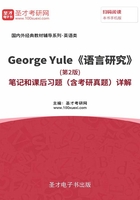
第7章 词与构词法
7.1 复习笔记
语言具有任意性,有些新词的产生完全是偶然的。例如hoover(电动吸尘器)源自吸尘器生产商William.H.Hoover的大名。
本章要点:
Word-formation processes of Modern English现代英语的构词法
本章考点:
现代英语的构词法:造词、借词、合成、混合、缩略、逆构、转换、首字母缩略、派生的定义和构成形式,前缀、后缀和中缀。
本章内容索引:
I. Words
1.Neologism
2.Etymology
II. Word-formation processes
1.Coinage
2.Borrowing
3.Compounding
4.Blending
5.Clipping
6.Back formation
7.Conversion
8.Acronym
9.Derivation
III. Multiple processes
I. Words(词汇)
1.Neologism(新词)
Neologism means a new word. 新词指的是新的单词。
2.Etymology(语源学)
Etymology refers to the study of the origin and history of words.
语源学指的是研究词的起源和历史。
II. Word-formation processes(构词法)
【考点】现代英语的构词法:造词、借词、合成、混合、缩略、逆构、转换、首字母缩略、派生的定义和构成形式
1.Coinage(造词法)
(1) Definition(定义)
Coinage is one of the least common processes of word-formation in English, that is, the invention of totally new terms.
造词法在英语构词法中是最不常用的方法,指的是完全创造新词。
(2) Examples(举例)
Older examples are aspirin, nylon and zipper; more recent examples are kleenex, teflon and xerox.
较早之前的例子有aspirin, nylon等和较近的Xeror, Kodax, Clone等词语都属于造词法。
2.Borrowing(借词法)
(1) Definition(定义)
One of the most common sources of new words in English is the process simply labeled borrowing, that is, the taking over of words from other languages.
e.g. croissant (French), dope (Dutch), lilac (Persian).
另一获得新词的最常见的手段是从别的语言中借用某些词,被称为借词法。
(2) Loan translation(借译)
A type of borrowing in which each element of a word is translated into the borrowing language, also called calque.
Examples are the French term gratte-ciel, which literally translates as ‘scrape-sky’, the Dutch wolkenkrabber (‘cloud scratcher’) or the German Wolkenkratzer (‘cloud scraper’), all of which were calques for the English skyscraper.
借译是借词的一种,单词中的所有成分都译入自己的语言中,也被称为“语义转借”。
3.Compounding(合成法)
(1) Definition(定义)
This combining process of joining two separate words to produce a single form technically known as compounding.
合成法就是把两个自由语素组合起来产生一个新词汇的过程。
(2) Examples(举例)
English examples: bookcase, fingerprint, sunburn, wallpaper, doorknob, textbook, wastebasket and waterbed.
英语中的bookcase、fingerprint、sunburn等都是合成词。
4.Blending(混合构词法)
(1) Definition(定义)
This combining of two separate forms to produce a single new term is also present in the process called blending.
However, blending is typically accomplished by taking only the beginning of one word and joining it to the end of the other word.
混合构词法就是把原来两个单词的部分去掉,把剩余的部分组合起来构成一个新的单词的过程。
通常是将一个词的首部与另一个词的尾部结合在一起构成新词。
(2) Examples(举例)
Brunch comes from breakfast and lunch.
Smog comes from smoke and fog.
例如breakfast和lunch合成brunch,smoke和fog合成smog。
5.Clipping(缩略法)
(1) Definition(定义)
The element of reduction which is noticeable in blending is even more apparent in the process described as clipping. This occurs when a word of more than one syllable (facsimile) is reduced to a shorter form (fax), often in casual speech.
有时人们将多音节词缩略成较短的词,这一过程即缩略法。它通过删除原词的一个或更多音节来缩短原词以产生新词,通常用于非正式文体。
(2) Examples(举例)
Facsimile is reduced to a shorter form fax. Other examples are ad (advertisement), bra (brassiere), cab (cabriolet).
facsimile可以缩略为fax,等等。
6.Backformation(逆构词法)
(1) Definition(定义)
A very specialized type of reduction process is known as backformation. Typically, a word of one type (usually a noun) is reduced to form another word of a different type (usually a verb).
有时把一种词性(通常为名词)的词缩减成另一种词性的词(通常是动词),这种缩减过程称为逆构。
(2) Examples(举例)
The noun television first came into use and then the verb televise was created from it. Other examples of words created by this process are: donate (from ‘donation’), enthuse (from ‘enthusiasm’).
先有名词television,之后才出现动词televise。其它例子还有:donate(来自于donation)等。
(3) Hypocorism(昵称)
A word-formation process in which a longer word is reduced to a shorter form with -y or -ie at the end (e.g. telly, movie).
长单词缩减为短的单词,并在词尾加上-y或-ie(比如,telly, movie)。
7.Conversion(词类转换法)
(1) Definition(定义)
A change in the function of a word, as, for example, when a noun comes to be used as a verb (without any reduction), is generally known as conversion. Other labels for this very common process are ‘category change’ and ‘functional shift’.
当一个词改变词性,获得不同语法功能时,该词经历了转换过程。其它的标志还包括“范畴的改变”和“功能的改变”。
(2) Examples(举例)
A number of nouns, such as paper, butter, bottle, vacation, can, via the process of conversion, come to be used as verbs.
很多的名词比如paper, butter, bottle, vacation都能转化为动词。
8.Acronym(首字母缩略法)
(1) Definition(定义)
Some new words, known as acronyms, are formed from the initial letters of a set of other words.
首字母缩略法是通过把若干单词的首字母大写组合在一起产生新词的过程。
(2) Examples(举例)
CD (‘compact disk’) or VCR (‘video cassette recorder’)
NASA or UNESCO.
9.Derivation(派生法)
【考点】前缀、后缀和中缀,粘着语素
(1) Definition(定义)
Derivation is the process of forming new words by adding affixes. It is by far the most common word-formation process to be found in the production of new English words.
派生法是借助前缀或后缀制造出新词的方法,是至今为止英文中最常用的造词法。
(2) Affix(词缀)
It is a bound morpheme such as un- or -ed added to a word (e.g. undressed).
①Prefix: a bound morpheme added to the beginning of a word (e.g. un-).
②Suffix:a bound morpheme added to the end of a word (e.g. -ed, -ness).
③Infix: a morpheme that is inserted in the middle of a word. It is not normally to be found in English, but fairly common in some other languages.
词缀为粘着词素,比如将un-或-ed添加到单词(例如undressed)。
①前缀:加在单词前面的粘着词素(例如un-)。
②后缀:加在单词后面的粘着词素(例如-ed, -ness)。
③中缀:插在单词中间的词素。中缀在英语中很少见,但在其它语言中常见。
(3) Bound morpheme(粘着语素)
A morpheme such as un- or -ed that cannot stand alone and must be attached to another form.
像un-或-ed不能单独使用,必须粘附在其他词素上构成单词的语素。
III. Multiple processes(多重过程)
It is possible to trace the operation of more than one process at work in the creation of a particular word.
Analogy is a process of forming a new word to be similar in some way to an existing word.
一个新单词的产生有可能涉及不止一种构词法。
类比指以某个现存的同类词为模式,进行联想类比,替换其中的某个词素,形成新词的过程。